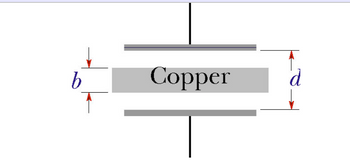
College Physics
11th Edition
ISBN: 9781305952300
Author: Raymond A. Serway, Chris Vuille
Publisher: Cengage Learning
expand_more
expand_more
format_list_bulleted
Concept explainers
Question
A slab of copper of thickness b = 1.081 mm is thrust into a parallel-plate capacitor of C = 1.00×10-11 F of gap d = 8.0 mm, as shown in the figure; it is centered exactly halfway between the plates.
a) What is the capacitance after the slab is introduced?
b)If a charge q = 1.00×10-6 C is maintained on the plates, what is the ratio of the stored energy before to that after the slab is inserted?
c)How much work is done on the slab as it is inserted?
d) Is the slab pulled in or must it be pushed in?
pulled or pushed

Transcribed Image Text:The image depicts a diagram illustrating a copper section sandwiched between two different materials. The copper is labeled centrally. There are two arrows, one on the left and one on the right, indicating measurements.
- On the left side of the copper, the arrow is labeled \(b\).
- On the right side, the arrow is labeled \(d\).
This could represent the thickness or spacing in a cross-sectional view of a material setup. The copper might be a part of an electrical component or heat transfer system, where understanding the dimensions \(b\) and \(d\) is crucial for calculations or design. The copper is shown in a horizontal alignment between the other materials or components with perpendicular lines on each side denoting continuation or connection to external elements.
Expert Solution
This question has been solved!
Explore an expertly crafted, step-by-step solution for a thorough understanding of key concepts.
Step by stepSolved in 4 steps with 4 images

Knowledge Booster
Learn more about
Need a deep-dive on the concept behind this application? Look no further. Learn more about this topic, physics and related others by exploring similar questions and additional content below.Similar questions
- please helparrow_forwardThe voltage across an air-filled parallel-plate capacitor is measured to be V1 =106.0 V. When a dielectric is inserted and completely fills the space between the plates, as in the figure below, the voltage drops to V2 =31.2 V. (a) What is the dielectric constant of the inserted material? (b) If the dielectric doesn't completely fill the space between the plates, what could you conclude about the voltage across the plates?arrow_forwardA certain substance has a dielectric constant of 3.8 and a dielectric strength of 25 MV/m. If it is used as the dielectric material in a parallel-plate capacitor, what minimum area should the plates of the capacitor have to obtain a capacitance of 5.3 × 10-2 µ F and to ensure that the capacitor will be able to withstand a potential difference of 3.1 kV?arrow_forward
- A slab of copper of thickness b = 1.68 mm is thrust into a parallel-plate capacitor of plate area A = 1.96 cm2 and plate separation d = 5.35 mm, as shown in the figure; the slab is exactly halfway between the plates. (a) What is the capacitance after the slab is introduced? (b) If a charge q = 2.68 µC is maintained on the plates, what is the ratio of the stored energy before to that after the slab is inserted? (c) How much work is done on the slab as it is inserted? (d) Is the slab sucked in or must it be pushed in? Copper (a) Number 4.73e-13 Units (b) Number i 0.686 (c) Number i 5.36e-10 Units J (d) sucked inarrow_forwardA parallel-plate capacitor consists of two circular plates that each have a radius of 12 cm, which are separated by a distance of 2.0 mm. What is the capacitance if the space between the plates is filled with paper (K = 3.5)?arrow_forward
arrow_back_ios
arrow_forward_ios
Recommended textbooks for you
 College PhysicsPhysicsISBN:9781305952300Author:Raymond A. Serway, Chris VuillePublisher:Cengage Learning
College PhysicsPhysicsISBN:9781305952300Author:Raymond A. Serway, Chris VuillePublisher:Cengage Learning University Physics (14th Edition)PhysicsISBN:9780133969290Author:Hugh D. Young, Roger A. FreedmanPublisher:PEARSON
University Physics (14th Edition)PhysicsISBN:9780133969290Author:Hugh D. Young, Roger A. FreedmanPublisher:PEARSON Introduction To Quantum MechanicsPhysicsISBN:9781107189638Author:Griffiths, David J., Schroeter, Darrell F.Publisher:Cambridge University Press
Introduction To Quantum MechanicsPhysicsISBN:9781107189638Author:Griffiths, David J., Schroeter, Darrell F.Publisher:Cambridge University Press Physics for Scientists and EngineersPhysicsISBN:9781337553278Author:Raymond A. Serway, John W. JewettPublisher:Cengage Learning
Physics for Scientists and EngineersPhysicsISBN:9781337553278Author:Raymond A. Serway, John W. JewettPublisher:Cengage Learning Lecture- Tutorials for Introductory AstronomyPhysicsISBN:9780321820464Author:Edward E. Prather, Tim P. Slater, Jeff P. Adams, Gina BrissendenPublisher:Addison-Wesley
Lecture- Tutorials for Introductory AstronomyPhysicsISBN:9780321820464Author:Edward E. Prather, Tim P. Slater, Jeff P. Adams, Gina BrissendenPublisher:Addison-Wesley College Physics: A Strategic Approach (4th Editio...PhysicsISBN:9780134609034Author:Randall D. Knight (Professor Emeritus), Brian Jones, Stuart FieldPublisher:PEARSON
College Physics: A Strategic Approach (4th Editio...PhysicsISBN:9780134609034Author:Randall D. Knight (Professor Emeritus), Brian Jones, Stuart FieldPublisher:PEARSON

College Physics
Physics
ISBN:9781305952300
Author:Raymond A. Serway, Chris Vuille
Publisher:Cengage Learning

University Physics (14th Edition)
Physics
ISBN:9780133969290
Author:Hugh D. Young, Roger A. Freedman
Publisher:PEARSON

Introduction To Quantum Mechanics
Physics
ISBN:9781107189638
Author:Griffiths, David J., Schroeter, Darrell F.
Publisher:Cambridge University Press

Physics for Scientists and Engineers
Physics
ISBN:9781337553278
Author:Raymond A. Serway, John W. Jewett
Publisher:Cengage Learning

Lecture- Tutorials for Introductory Astronomy
Physics
ISBN:9780321820464
Author:Edward E. Prather, Tim P. Slater, Jeff P. Adams, Gina Brissenden
Publisher:Addison-Wesley

College Physics: A Strategic Approach (4th Editio...
Physics
ISBN:9780134609034
Author:Randall D. Knight (Professor Emeritus), Brian Jones, Stuart Field
Publisher:PEARSON